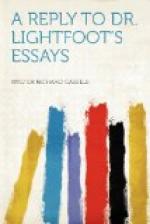Now first as regards the facts. I do not maintain the priority of the Curetonian Epistles in this book myself; indeed I express no personal opinion whatever regarding them which is not contained in that general declaration of belief, the decision of which excites the wrath of my diffident critic, that the Epistles in no form have “any value as evidence for an earlier period than the end of the second or beginning of the third century, even if they have any value at all.” I merely represent the opinion of others regarding those Epistles. Dr. Lightfoot very greatly exaggerates the importance attached to the Armenian version, and I call special attention to the passages in the above quotation which I have taken the liberty of italicising. I venture to say emphatically that, so far from being considered the “key of the position,” this version has, with some exceptions, played a most subordinate and insignificant part in the controversy, and as Dr. Lightfoot has expressly mentioned certain writers, I will state how the case stands with regard to them. Weiss, Lipsius, Uhlhorn, Merx, and Zahn certainly “more or less prominently” deal with them. Denzinger, however, only refers to Petermann’s publication, which appeared while his own brochure was passing through the press, in a short note at the end, and in again writing on the Ignatian question, two years after, [79:1] he does not even allude to the Armenian version. Beyond the barest historical reference to Petermann’s work, Hilgenfeld does not discuss the Armenian version at all. So much for the writers actually mentioned by Dr. Lightfoot.
As for “the writers who have specially discussed the Ignatian question during the last quarter of a century:” Cureton apparently did not think it worth while to add anything regarding the Armenian version of Petermann after its appearance; Bunsen refutes Petermann’s arguments in a few pages of his “Hippolytus;” [79:2] Baur, who wrote against Bunsen and the Curetonian letters, and, according to Dr. Lightfoot’s representation, should have found this “the most formidable argument” against them, does not anywhere, subsequent to their publication, even allude to the Armenian Epistles; Ewald, in a note of a couple of lines, [79:3] refers to Petermann’s Epistles as identical with a post-Eusebian manipulated form of the Epistles which he mentions in a sentence in his text; Dressel devotes a few unfavourable lines to them; [80:1] Hefele [80:2] supports them at somewhat greater length; but Bleek, Volkmar, Tischendorf, Boehringer, Scholten, and others have not thought them worthy of special notice; at any rate none of these nor any other writers of any weight have, so far as I am aware, introduced them into the controversy at all.




